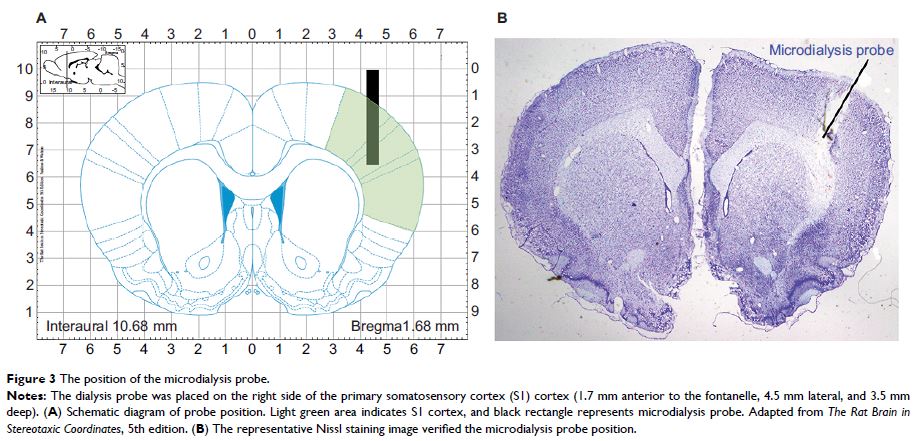108384
论文已发表
注册即可获取德孚的最新动态
IF 收录期刊
- 3.4 Breast Cancer (Dove Med Press)
- 3.2 Clin Epidemiol
- 2.6 Cancer Manag Res
- 2.9 Infect Drug Resist
- 3.7 Clin Interv Aging
- 5.1 Drug Des Dev Ther
- 3.1 Int J Chronic Obstr
- 6.6 Int J Nanomed
- 2.6 Int J Women's Health
- 2.9 Neuropsych Dis Treat
- 2.8 OncoTargets Ther
- 2.0 Patient Prefer Adher
- 2.2 Ther Clin Risk Manag
- 2.5 J Pain Res
- 3.0 Diabet Metab Synd Ob
- 3.2 Psychol Res Behav Ma
- 3.4 Nat Sci Sleep
- 1.8 Pharmgenomics Pers Med
- 2.0 Risk Manag Healthc Policy
- 4.1 J Inflamm Res
- 2.0 Int J Gen Med
- 3.4 J Hepatocell Carcinoma
- 3.0 J Asthma Allergy
- 2.2 Clin Cosmet Investig Dermatol
- 2.4 J Multidiscip Healthc

在大鼠初级躯体感觉皮层区的氨基酸神经递质释放增加导致产生由瑞芬太尼诱导的痛觉过敏及其对利多卡因的抑制作用
Authors Wang S, Cui W, Zeng M, Ren Y, Han S, Li J
Received 13 March 2018
Accepted for publication 15 May 2018
Published 14 August 2018 Volume 2018:11 Pages 1521—1529
DOI https://doi.org/10.2147/JPR.S168008
Checked for plagiarism Yes
Review by Single-blind
Peer reviewers approved by Dr Justinn Cochran
Peer reviewer comments 2
Editor who approved publication: Dr E Alfonso Romero-Sandoval
Background: Studies have confirmed that activation of the neurons of primary somatosensory cortex (S1) is involved in the process of remifentanil (Remi)-induced hyperalgesia (RIH), which can be suppressed by lidocaine (Lido). A total intravenous anesthesia model of rats mimicking clinical Remi-based anesthesia was set up to explore the release of amino acid neurotransmitters of S1 cortex in RIH and its inhibition by Lido in this study.
Materials and methods: Sprague Dawley rats were randomly divided into the following four groups: propofol (Pro), Remi, Remi combined Lido, and Lido groups. Mechanical hyperalgesia was evaluated by von Frey test; the amino acid neurotransmitters in the microdialysates of S1 area were detected by high-performance liquid chromatography (HPLC)-fluorescence, and conventional protein kinase C (cPKC)γ levels in the whole-cell lysates and membrane lipid rafts (MLRs) were determined by Western blotting.
Results: The von Frey test showed that co-administration of Lido significantly inhibited a Remi-induced decrease in the threshold of the paw withdrawal response in Remi group at 2 h postinfusion. Meanwhile, the Remi-induced increases in both the excitatory and inhibitory amino acid releases in S1 were suppressed by co-administrating Lido within 5 h postinfusion. Western blotting showed that the increased cPKCγ level in the membrane lipid rafts (MLR) induced by Remi was also inhibited by Lido.
Conclusion: The increased release of amino acid neurotransmitters and the translocation of cPKCγ in MLR suggest the activation of S1 neurons, which may be one of the mechanisms underlying RIH. Lido reduces the release of amino acid neurotransmitters in S1 neurons and the translocation of cPKCγ in MLRs after stopping Remi, which may be one of its antihyperalgesic mechanisms.
Keywords: hyperalgesia, remifentanil, lidocaine, amino acid neurotransmitter, protein kinase C
